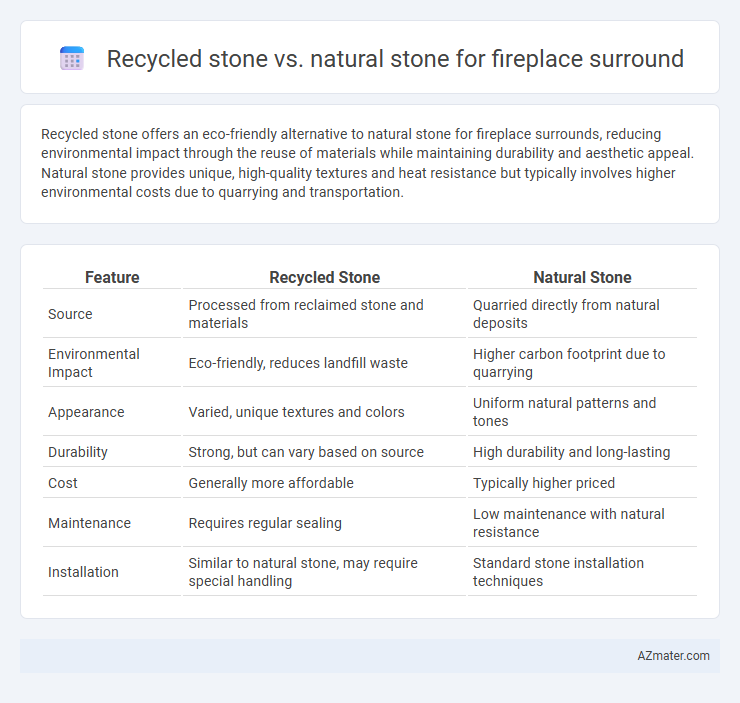Recycled stone offers an eco-friendly alternative to natural stone for fireplace surrounds, reducing environmental impact through the reuse of materials while maintaining durability and aesthetic appeal. Natural stone provides unique, high-quality textures and heat resistance but typically involves higher environmental costs due to quarrying and transportation.
Table of Comparison
| Feature | Recycled Stone | Natural Stone |
|---|---|---|
| Source | Processed from reclaimed stone and materials | Quarried directly from natural deposits |
| Environmental Impact | Eco-friendly, reduces landfill waste | Higher carbon footprint due to quarrying |
| Appearance | Varied, unique textures and colors | Uniform natural patterns and tones |
| Durability | Strong, but can vary based on source | High durability and long-lasting |
| Cost | Generally more affordable | Typically higher priced |
| Maintenance | Requires regular sealing | Low maintenance with natural resistance |
| Installation | Similar to natural stone, may require special handling | Standard stone installation techniques |
Introduction to Fireplace Surround Materials
Recycled stone offers an eco-friendly alternative to natural stone by incorporating reclaimed materials that reduce environmental impact and promote sustainability. Natural stone, such as granite, marble, or limestone, provides timeless beauty, durability, and heat resistance essential for fireplace surrounds. Selecting between recycled and natural stone depends on factors like aesthetic preference, budget, and the desire for environmentally conscious building materials.
What is Recycled Stone?
Recycled stone consists of reclaimed materials sourced from demolished buildings, old countertops, and other stone surfaces, repurposed for new applications like fireplace surrounds. This eco-friendly option reduces landfill waste and often features unique textures and colors unavailable in natural stone. Compared to natural stone, recycled stone offers sustainability benefits while maintaining durability and aesthetic appeal for interior design.
Defining Natural Stone for Fireplaces
Natural stone for fireplace surrounds consists of quarried materials like granite, marble, limestone, and slate, valued for their unique textures, durability, and heat resistance. Each type of natural stone offers distinct aesthetic qualities and can withstand high temperatures without degrading, making them ideal for fireplace applications. The natural variation in color and pattern enhances the fireplace's visual appeal while providing lasting structural integrity.
Appearance and Aesthetic Differences
Recycled stone fireplace surrounds often exhibit a unique, variegated texture and color palette created by blending diverse stone fragments, offering an eco-friendly alternative with a rustic, handcrafted appearance. Natural stone fireplace surrounds provide consistent, authentic patterns and rich natural hues, such as granite's speckled finish or marble's elegant veining, delivering a timeless and luxurious aesthetic. The choice between recycled and natural stone impacts the surround's visual texture and uniformity, influencing the overall ambiance and design style of the fireplace area.
Environmental Impact: Recycled vs Natural Stone
Recycled stone for fireplace surrounds significantly reduces environmental impact by minimizing the need for quarrying, lowering energy consumption, and diverting waste from landfills compared to natural stone. Natural stone extraction involves extensive mining operations that disrupt ecosystems, increase carbon emissions, and deplete non-renewable resources. Choosing recycled stone supports sustainable construction by promoting material reuse and reducing the carbon footprint associated with fireplace surround installations.
Durability and Longevity Comparison
Recycled stone fireplace surrounds offer impressive durability, often matching the hardness and resistance of natural stone due to advanced processing techniques that enhance material strength. Natural stone, such as granite or limestone, is renowned for its exceptional longevity, withstanding heat and wear over decades without significant deterioration. Both materials provide long-lasting fireplace surrounds, but natural stone generally offers superior lifespan in extreme conditions, while recycled stone presents a sustainable yet resilient alternative.
Cost Analysis: Upfront and Long-Term Expenses
Recycled stone for fireplace surrounds offers lower upfront costs due to reduced quarrying and processing expenses compared to natural stone, which often involves higher extraction and transportation fees. Long-term expenses for recycled stone tend to be minimal as it resists wear and requires less maintenance, whereas natural stone may incur additional costs for sealing and repairs over time. Budget-conscious homeowners benefit from recycled stone's cost-effectiveness without compromising durability or aesthetic appeal.
Installation Process and Challenges
Recycled stone for fireplace surrounds offers easier installation due to its uniform size and lighter weight compared to natural stone, reducing the need for heavy machinery and extensive labor. Natural stone, while providing a unique and authentic appearance, often requires skilled masons for precise cutting and fitting, increasing installation time and complexity. Challenges with recycled stone include potential inconsistencies in durability, whereas natural stone may present issues with irregular shapes and higher transportation costs impacting overall project logistics.
Maintenance and Cleaning Requirements
Recycled stone fireplace surrounds typically require less maintenance due to their enhanced durability and resistance to staining compared to natural stone. Natural stone, such as marble or limestone, often demands regular sealing and specialized cleaning products to prevent damage and discoloration over time. Both materials benefit from routine dusting and mild soap solutions, but recycled stone offers a more low-maintenance option ideal for busy households.
Which Stone Option Is Best for Your Fireplace Surround?
Recycled stone offers an eco-friendly and cost-effective alternative to natural stone for fireplace surrounds, often featuring a unique blend of colors and textures created from reclaimed materials. Natural stone such as granite, marble, or limestone provides unparalleled durability, heat resistance, and timeless aesthetic appeal, making it ideal for high-heat environments and long-term investment. Choosing between recycled and natural stone depends on priorities like environmental impact, budget, and desired visual character for the fireplace surround.

Infographic: Recycled stone vs Natural stone for Fireplace surround
 azmater.com
azmater.com